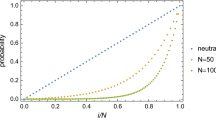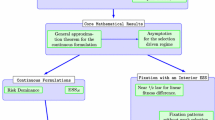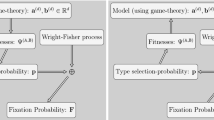Abstract
We use the Bernstein polynomials of degree d as the basis for constructing a uniform approximation to the rate of evolution (related to the fixation probability) of a species in a two-component finite-population, well-mixed, frequency-dependent evolutionary game setting. The approximation is valid over the full range \(0 \le w \le 1\), where w is the selection pressure parameter, and converges uniformly to the exact solution as \(d \rightarrow \infty \). We compare it to a widely used non-uniform approximation formula in the weak-selection limit (\(w \sim 0\)) as well as numerically computed values of the exact solution. Because of a boundary layer that occurs in the weak-selection limit, the Bernstein polynomial method is more efficient at approximating the rate of evolution in the strong selection region (\(w \sim 1\)) (requiring the use of fewer modes to obtain the same level of accuracy) than in the weak selection regime.



Similar content being viewed by others
References
Altrock PM, Traulsen A (2009) Fixation times in evolutionary games under weak selection. New J Phys 11:013012
Bender CM, Orszag SA (1999) Advance mathematical methods for scientists and engineers I: asymptotic methods and perturbation theory. Springer-Verlag, Berlin
Bernstein S (1912) Démonstration du théorème de Weierstrass fondée sur le calcul des probabilités (Proof of the theorem of Weierstrass based on the calculus of probabilities). Commun Kharkov Math Soc 13(1):1–2
Dua R, Ma Y, Newton P K (2021) Are adaptive chemotherapy schedules robust? A three-strategy stochastic evolutionary game theory model. Cancers 13:12. https://doi.org/10.3390/cancers13122880
Estep D (2011) Practical analysis in one variable. Springer, Berlin
Farouki RT (2012) The Bernstein polynomial basis: a centennial retrospective. Comp Aided Geo Des 29:379–419
Kimura M (1968) Evolutionary rate at the molecular level. Nature 217:624–626
Ma Y, Newton PK (2021) Role of synergy and antagonism in designing multidrug adaptive chemotherapy schedules. Phys Rev E 103:032408
Newton PK, Ma Y (2019) Nonlinear adaptive control of competitive release and chemotherapeutic resistance. Phys Rev E 99:022404
Nowak MA (2006) Evolutionary dynamics: exploring the equations of life. Harvard University Press, Cambridge
Nowak MA, Sasaki A, Taylor C, Fudenberg D (2004) Emergence of cooperation and evolutionary stability in finite populations. Nature 428:646–650
Park J, Newton PK (2022) Stochastic competitive release and adaptive chemotherapy. bioRxiv. https://doi.org/10.1101/2022.06.17.496594
Ross S (2010) Introduction to probability models, 10th edn. Elsevier, Amsterdam
Totik V (1994) Approximation by Bernstein polynomials. Am J Math 116(4):995–1018
Traulsen A, Pacheco JM, Imho LA (2006) Stochasticity and evolutionary stability. Phys Rev E 58:021905
West J, You L, Zhang J, Gatenby RA, Brown JS, Newton PK, Anderson ARA (2020) Towards multidrug adaptive therapy. Cancer Res 80:1578–1589. https://doi.org/10.1158/0008-5472.CAN-19-2669
Wild G, Traulsen A (2007) The different limits of weak selection and the evolutionary dynamics of finite populations. J Theor Biol 247:382–390
Acknowledgements
We gratefully acknowledge support from the Army Research Office MURI Award \(\#\)W911NF1910269 (2019–2024) as well as useful conversations and suggestions from Prof. Kukavica and Prof. Ziane.
Funding
We gratefully acknowledge support from the Army Research Office MURI Award \(\#\)W911NF1910269 (2019–2024).
Author information
Authors and Affiliations
Contributions
PN and JP both conceived of the project. JP produced the figures. PN wrote the manuscript. Both authors proofread and edited the manuscript.
Corresponding author
Ethics declarations
Conflict of interest
The authors have no competing interests to declare.
Availability of Data and Materials
All code is available to readers on request to the corresponding author.
Additional information
Publisher's Note
Springer Nature remains neutral with regard to jurisdictional claims in published maps and institutional affiliations.
Rights and permissions
Springer Nature or its licensor (e.g. a society or other partner) holds exclusive rights to this article under a publishing agreement with the author(s) or other rightsholder(s); author self-archiving of the accepted manuscript version of this article is solely governed by the terms of such publishing agreement and applicable law.
About this article
Cite this article
Park, J., Newton, P.K. Bernstein Polynomial Approximation of Fixation Probability in Finite Population Evolutionary Games. Dyn Games Appl (2023). https://doi.org/10.1007/s13235-023-00509-8
Accepted:
Published:
DOI: https://doi.org/10.1007/s13235-023-00509-8




